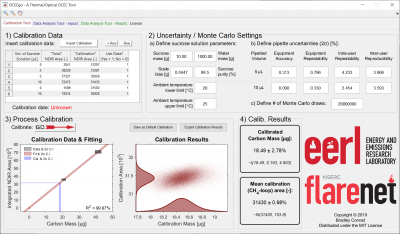A secondary output from EERL’s recent laboratory effort to measure black carbon optical properties from lab-scale gas flares was the development of a software tool to support measurements of flare-generated carbon mass. One instrument that enables the measurement of carbon mass concentration in a particle-laden sample of air is the thermal-optical elemental/organic carbon (OCEC) analyzer. At the Carleton Vertical Flare Facility, a semi-continuous OCEC instrument is employed used to obtain a measure of emitted organic and elemental carbon from the flame, which can support the quantification of properties and emissions of carbon from the flare.

Screenshot of OCECgo’s calibration tool showing representative results for a calibration performed at EERL.
The software tool, OCECgo, is a MATLAB-based user interface that enables the robust quantification of uncertainties in the calibration and operation of the OCEC instrument via Monte Carlo method. This tool was relied upon heavily in the recent study of flare-generated black carbon absorption (published in Carbon) and is parsed into two separate utilities:
- Calibration Tool: This utility computes the calibration constants of the OCEC instrument for the user. The user inputs the nominal calibration data and several contributing source of uncertainty into the software. The utility then computes the calibration constants and associated uncertainties using a Monte Carlo method that propagates contributing uncertainty sources into the calibration constants.
- Data Analysis Tool: Following calibration and quantification of uncertainties using the Calibration Tool, the user can then use the software to perform a rigorous, Monte Carlo-based analysis of measurement data to compute organic, elemental, and total carbon masses captured by the OCEC filter. Sources of uncertainty that are propagated through this technique include: calibration uncertainty, uncertainties in the correction of laser power and the NDIR detector, and (for the first time) uncertainties in the estimation of split point. Upon running the analysis, the user is provided with statistics and a posterior distribution for each of the three carbon masses.
OCECgo is offered as an open-source tool under the MIT License and is available on GitHub, with a complete documentation set hosted by Read the Docs. A publication presenting the software is currently in press with the Journal of Visualized Experiments, with a video tutorial scheduled for release in the summer of 2019.

Publication
B.M. Conrad, M.R. Johnson (2019) Split point analysis and uncertainty quantification of thermal-optical organic / elemental carbon measurements, Journal of Visualized Experiments, (in press)